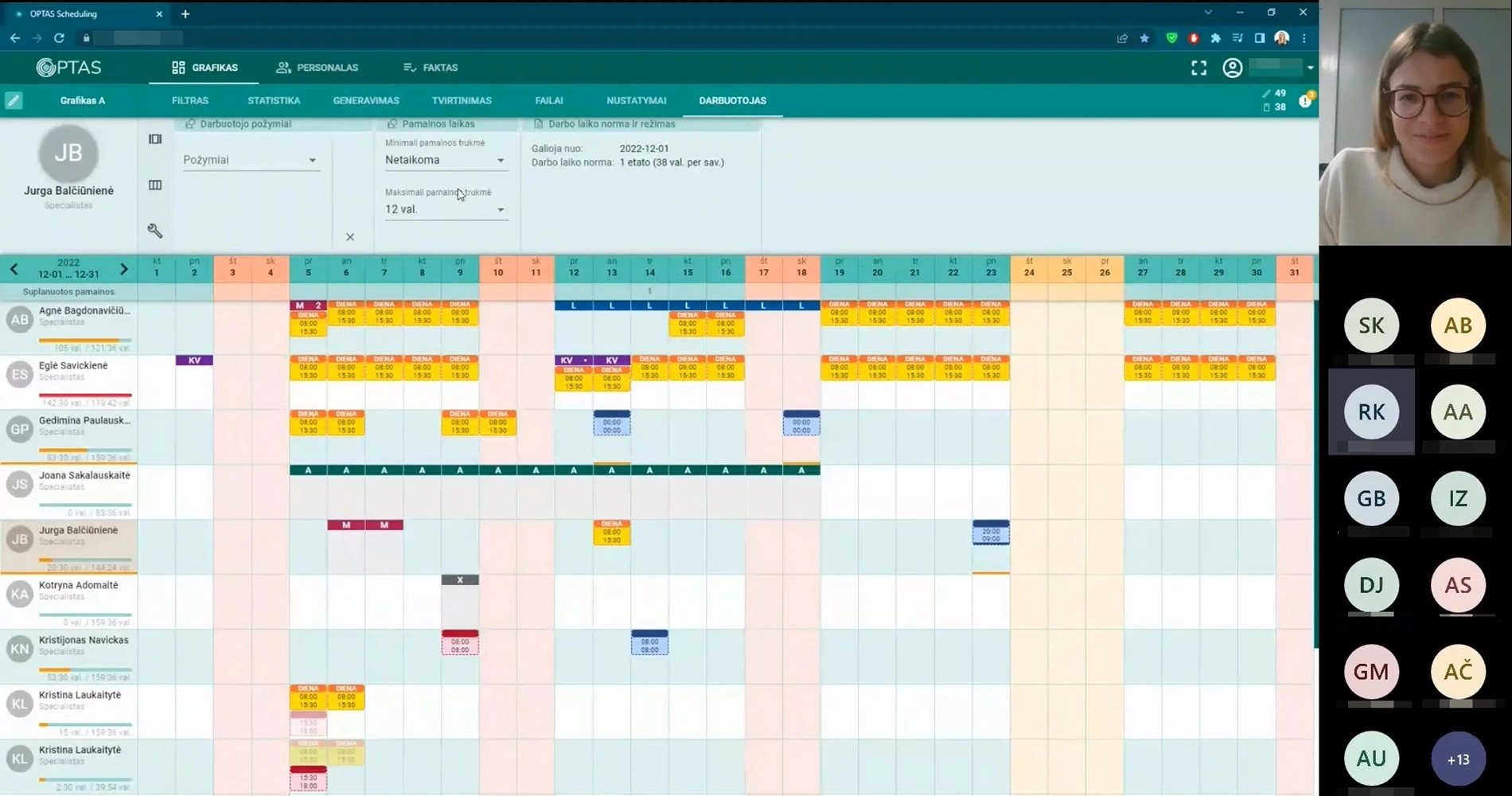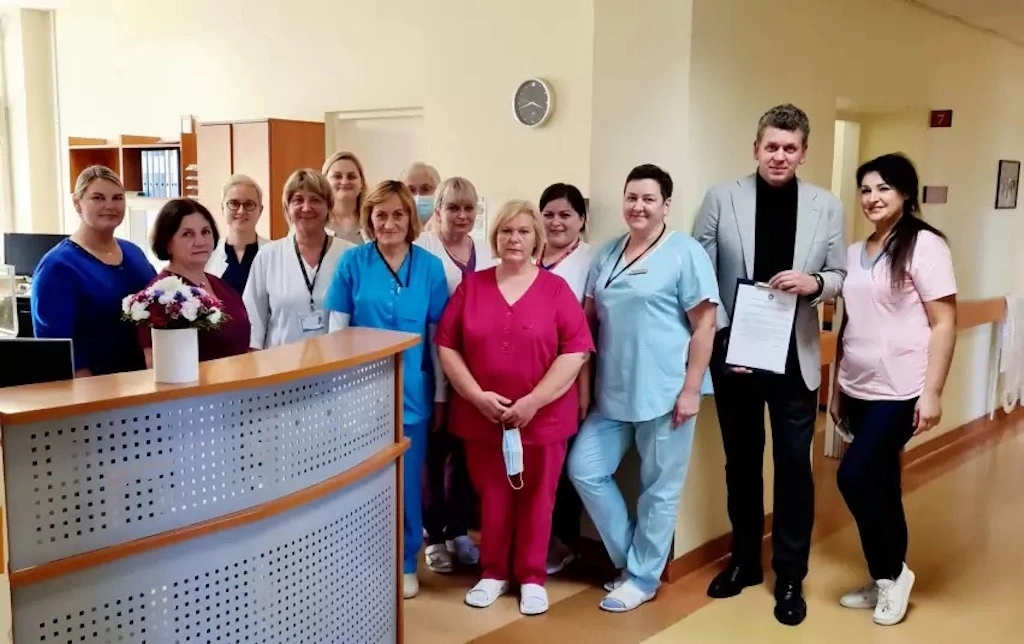Siauliai Hospital is one of the biggest healthcare institutions in Lithuania. With over 2400 workers and multiple departments, the hospital administration is responsible for scheduling employees to meets the needs of every patient.
Before starting to work with us, Siauliai Hospital relied on outdated employee management software and manual work. They decided to give OPTAS employee scheduling software a try to automate the scheduling process and avoid errors. Within the first months of implementing OPTAS, Siauliai Hospital significantly increased its scheduling speed and connected all hospital workers and departments through one system.
The challenge: slow processes and scheduling errors
Even though the hospital used a digital system to digitize scheduling, they still did most of the work manually as their system wasn’t capable of creating schedules by itself. Before automating its employee management and scheduling processes, Siauliai Hospital faced many challenges.
- Managing 2400 employees with different working hours and scheduling types.
- Using a banked-hour method to plan shifts, the hospital struggled to register and track all the information through a 4-month accounting period.
- Manual scheduling would result in human errors and labor law violations.
- Some employees worked in different departments. This made it extra hard to schedule them across multiple departments, communicate, and share information.
- Final schedules used to be hung in the lounge or other public room on a piece of paper. This made it difficult to make changes, shift swaps, and notify everyone involved, as well as follow schedules.
- The previous system didn't have a data backup feature. In case of system failure, the schedule together with all data would be lost.
- The old program couldn't be integrated with other systems. On top of making schedules, accountants also had to manually input data at the end of each month into the payroll systems. More manual work meant more mistakes and human resources going through the roof.
Launching and training process
The hospital administration had to do something. However, not only did they have to find a more modern system, but they also had to onboard all the departments and workers to use this new system.
When we started preparing to launch OPTAS in Siauliai Hospital, we knew that training so many employees would be a challenge. At OPTAS, we’re a small team, but that's what gave us an advantage. We know how to make our service and onboarding more personal.
To begin with, we started with a couple of people who were enthusiastic and looking forward to this new system. We focused on training these workers first so that once they knew how to use OPTAS, they could set an example for other employees and help them get started.
We divided the training process into 5 parts. In the first stage, we started onboarding departments that were the most interested in trying OPTAS. Then we moved on to other departments and employees.
Each week, we dedicated one to two hours to teaching different OPTAS features and processes. To consolidate the information, each department manager had to do homework and explore what they just learned on their own.
We also performed training for employees responsible for IT procedures. During these sessions, we explained how the scheduling software works on a more technical level.
To ease information exchange among employees and departments, we created a live chat where our consultants, hospital administrators, and other hospital workers could chat about the scheduling software and ask questions.
Soon, we noticed that the hospital staff could find all the necessary answers without our help. That's when we knew team training was a success. While the process of starting to work together took a few months, it was necessary for the success that followed.
Perfect solution for Siauliai Hospital
OPTAS offers a centralized system to automatically schedule employees across multiple departments and scheduling methods.
Here are the solutions Siauliai Hospital successfully uses:
Fully automated scheduling
Administrators only need to fill out employee data, the number of shifts they need on each day, and click generate to create schedules for all employees in minutes.
Cross-department scheduling
OPTAS applies rules for every department, so that managers can make sure their employees don’t have overlapping shifts or have enough rest time.
Employee preferences
Employees can enter their preferences themselves. OPTAS then creates schedules with their preferences in mind or notifies schedule makers when the rules are ignored.
Simplified vacation planning
Managers can select and enter employee vacations and see in advance if there will be enough employees to cover that department.
Compliance with labor laws
The system applies labor law requirements and automatically creates error-free schedules. When someone makes manual changes, the system highlights mistakes.
Automatic calculations
OPTAS automates calculations, tracks planned and worked hours. When calculating banked hours, accountants can see the hour balance for each employee from previous months.
Centralized system
It's a single system where administrators can post schedules for everyone to see, swap shifts, and approve employee requests within the system.
Integrations with other systems
Accountants with a click of a button can export data of thousands of employees in minutes into a payroll system.
Results
Since implementing the OPTAS employee scheduling solution, Siauliai Hospital has significantly improved its employee scheduling.
- 01
70% less time spent creating schedules
Now, 110 managers can automatically create schedules within minutes. Hospital administration can also create schedule templates, copy and paste them for the following months, and manually adjust small details.
- 02
Fewer errors
They avoid errors, inaccuracies, and labor law violations as the system automatically applies all the rules when generating schedules or notifies schedule coordinators of any mistakes or inaccuracies.
- 03
Simplified calculations for 2400+ employees working hours
Just last year there were 85 680 vacation days planned and 30 090 sick leave days registered on OPTAS. Imagine having to calculate that by hand. Managers can now track and calculate information more accurately as the system collects data on vacation and sick days, as well as holiday, night, along with other attendance data.
- 04
Notifying employees in seconds, not hours
Employees can now access their schedules from anywhere. Managers can make changes more easily on their phones or computers. This information reaches the right employees in seconds. They don’t need to search for the information in a lounge room or ask their colleagues.
- 05
70 departments can use one centralized system
All departments are now connected, making cross-department scheduling clearer and faster. Hospital administration can find all 202 different schedules in one place even through their phone.
- 06
85% faster timesheet information transfer into payroll systems
The hospital’s accountants can automatically import timesheet information to payroll, as OPTAS allows full integration. OPTAS also syncs information social insurance agencies to import sick leave information straight from a doctor.
OPTAS in your hospital
Do you think OPTAS could improve your employee scheduling? Let’s talk! We offer a free discovery call. During the call, we’ll look into your unique case and demonstrate how OPTAS software would work with your schedules.




